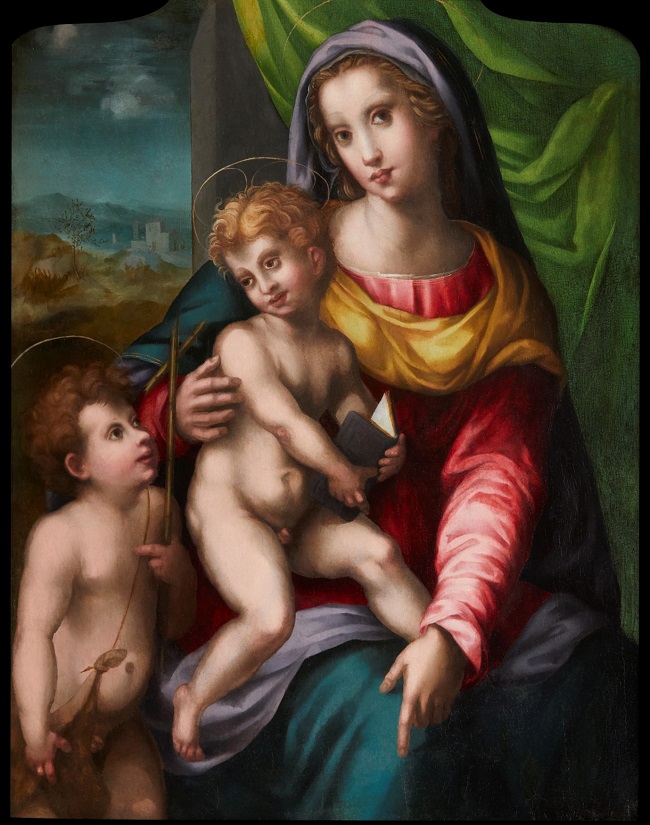Advent unveiling for intriguing Madonna and Child
Published: 5 December 2022
An Italian Renaissance painting of the Madonna and Child that has long been shrouded in mystery has gone on display following extensive restoration by a team including a UofG academic

An Italian Renaissance painting of the Madonna and Child that has long been shrouded in mystery has gone on display following extensive restoration.
The captivating image – painted in Florence in the 1520s – has been unveiled at Kirkcaldy Galleries, where it is being exhibited for the first time.
Conservation work has shed new light on who painted the picture and given curators fresh insights into the artist’s creative process and technique.
Leading edge technology has also revealed for the first time a shadowy image, believed to be Joseph, beneath layers of paint.
The restoration, which involved the Universities of Glasgow and Aberdeen, has inspired gallery staff to uncover another mystery – how the picture made its way from Florence to Fife.
Until now, little was known about the history of the painting, which depicts Mary holding the baby Jesus on her knee with the young Saint John the Baptist standing by their side.
A strip of paper on the back of the frame credits Andrea del Sarto (1486-1530) – a High Renaissance master from Florence – but experts who have studied the painting in recent years suggest otherwise.
Instead they credit the studio of acclaimed Florentine artist Domenico Puligo (1492-1527), who found success focusing on Madonna paintings. The great Renaissance art historian Giorgio Vasari praised Puligo for his use of colour and the ‘beautiful expressions’ of his subjects.
Paint samples taken by scientists at the University of Glasgow have helped to confirm the date of the work.
Using infrared photography to see beneath the paint, conservators also detected charcoal strokes that reveal how the artist figured out – and even changed – the picture’s composition.
And beneath the landscape scene in the top left corner of the painting, they identified a figure – most likely Joseph – who often appears in similar positions in Renaissance paintings.
Madonna and Child with the Infant Saint John the Baptist is the oldest painting in the extensive art collection managed by cultural charity OnFife, which runs Kirkcaldy Galleries.
New research suggests the painting was brought to Fife in the 1860s by retired Royal Navy surgeon Alexander Woodcock, who had set up a private museum of artefacts and curiosities in Anstruther.
Dr Woodcock made regular trips to Edinburgh by steamer to meet sellers and artists and it is thought the painting was most likely purchased on one of these visits.
The museum closed after Woodcock’s death and the painting was acquired by the local burgh council, which displayed it in Anstruther Town Hall. The painting later became part of the collection of Fife Council, now managed by OnFife.
Interest in the painting was revived in 2016 by Professor John Gash, a senior lecturer in History of Art at the University of Aberdeen, who first linked the painting to Domenico Puligo
The restoration has been supported by Fife Council’s Common Good Funds and the Woodmansterne Art Conservation Awards. The work was completed by Egan, Matthews & Rose of Dundee.
Madonna and Child with the Infant Saint John the Baptist is painted on wood, which was commonly used before being gradually replaced by canvas.
After cleaning and strengthening the poplar hardwood panel, conservators cleaned all dirt from the painting’s surface before removing varnish and overpaint traces from previous restorations.
This helped bring the original colour scheme back to life, correct the colour discrepancies of earlier conservation work and stabilise the paint layer.
Conservators also retouched the areas where the paint had been previously damaged or removed and corrected any discolouration and blemishes.
The painting was then varnished again to give the colours richness and to protect it from dirt and dust. Parts of its frame were also recast, repainted and refitted with low reflective glass.
An entire room has been set aside in Kirkcaldy Galleries for one year to tell the story of the conservation work and the recent research into the painting’s past.
“The restoration has been doubly satisfying process,” says Collections Curator Kirke Kooke. “Not only do we have a beautifully restored painting for visitors to enjoy, but a host of new insights into its story.”
First published: 5 December 2022
<< December

